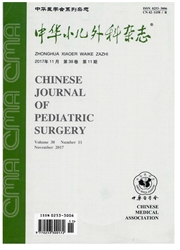

 中文摘要:
中文摘要:
目的通过动态观察正常人类胚胎的泄殖腔、尿直肠隔、肛门直肠的胚胎发育过程,探讨肛门直肠的胚胎发生机制和演变规律,为理解肛门直肠畸形的发生机制提供理论基础。方法收集胎龄3至8周人工流产手术后的人类胚胎标本108例,常规脱水,制备蜡块,行矢状面连续切片。HE染色,连续对比观察人类胚胎泄殖腔、尿直肠隔以及肛门直肠的形态改变。结果自第四周至第六周尿直肠隔向泄殖腔膜生长,将泄殖腔分隔为尿生殖窦和后肠两部分;直至第七周,肛门直肠与外界相通,直至此时始终未观察到尿直肠隔与背侧泄殖腔膜融合;在第八周,尿直肠隔转向腹侧,迅速生长最终与腹侧泄殖腔膜发生融合。结论在人类胚胎发育过程中,泄殖腔膜在泄殖腔发育过程中发挥了重要作用,背侧和腹侧泄殖腔膜分别参与了肛门直肠和尿生殖系统的发生发育。
 英文摘要:
英文摘要:
Objective The aim of this study is to determine whether the urogenital septum (URS) fuses with the cloacal membrane (CM) in humans. Methods One hundred and eight human embryos were harvested at the time of cloacal developmental,i, e. between the 3rd and 8th week of gestation. The embryos were sectioned sagittally and stained with hematoxylin and eosin (H&E). The relevant structures including cloaca and URS were evaluated in a temporospatial sequence. Results From the 4th to 6th week, the URS separated the cloaca into the urogenital sinus and the hindgut. Subsequently, this septum extended in the direction of CM. The fusion of the URS and dorsal CM were never observed before the anorectum communicated with exterior at the 7th week. During the 8th week, the URS fuses with the ventral CM and formation of the urethral tube involves septation of the urethral plate by continued growth of the URS. Conclusions These data suggested that the dorsal and ventral urogenital sinus are involved in the development of urogenital and anorectum systems respectively.
 同期刊论文项目
同期刊论文项目
 同项目期刊论文
同项目期刊论文
 期刊信息
期刊信息
